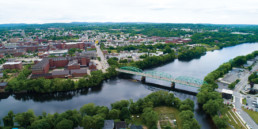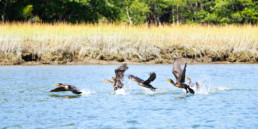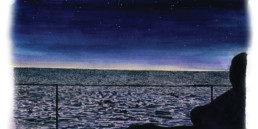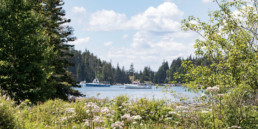John Marin’s Islands
American modernist painted these ‘tantalizingly beautiful’ sentinels
By Carl Little
In his poem “Sea-Change,” the late Philip Booth of Castine pays tribute to John Marin. First published in The New Yorker in 1956, the poem, written in Booth’s pared-down style, opens with the artist’s name then proceeds to accentuate his visceral connection to the Maine landscape:
Marin
saw how it feels:
the first raw shock
of Labrador current,
the surfacing gasp
at jut of rock,
bent sails, and wedged
trees.
In the next several lines, Booth expands on Marin’s powers of perception while evoking the calligraphic nature of his mark-making: “He wrote it:/Stonington, Small/Point, and Cape Split,/through a pane so/cracked by the lode-/star sun that he/swam back, blinded,/into himself to/sign the after-/image.”
The poet captures what art historians have come to call modernist energy, Marin’s ability to use an innovative visual language to represent the world, in this case, Maine:
“…mountains, ledged/towns (white as/Machias after/the hayrake rain),/sun-splintered/water and written/granite; dark light/unlike what you/ever saw…”
Toward the end of “Sea-Change,” Booth conjures a vision of one of Marin’s favorite subjects: “…until/inland, your own/eyes close and, out/of that sea-change,/islands rise thick…”
It’s a fitting image: from his first forays at Small Point in Phippsburg, through his sojourns in Stonington, and his final residence at Cape Split in South Addison way Downeast, Marin painted the archipelago, those isles that accent nearly every coastal horizon with their rocky edges and pointed firs. He was smitten.
The catalogue raisonné of Marin’s work, assembled by art historian Sheldon Reich and published in 1970, opens with several hundred thumbnails of New York City views, some European views, New Jersey landscapes, and images of Castorland in upstate New York. A resident of Cliffside, N.J., the artist had fanned out across the region—and abroad—to paint his impressions of places.
Then, in 1914, the first images of Maine appear, with a flourish: around 75 watercolors painted in the summer and fall near Marin’s rustic abode at the southern tip of Carrying Place Head off the coast of West Point in Phippsburg at the northern edge of Casco Bay. As Portland Press Herald art writer Bob Keyes recounted in a January 2017 article, Marin was drawn to the place by his friend Ernest Haskell (1876-1925), the well-known illustrator and printmaker who had taken up seasonal residence in Phippsburg in 1903.
Keyes notes that the 32-acre private island in the New Meadows River was accessible from the mainland for two hours at low tide, but that Marin preferred his rowboat (he would turn to a variety of boats, some motorized, to take him places during his Maine visits). He also mentions the painter’s hatred of mosquitoes, which are renowned for plaguing the area.
In the sixth edition of A Cruising Guide to the New England Coast, authors Roger Duncan and John Ware wrote that “the most voracious breed of mosquitoes ever developed has its headquarters” in Small Point Harbor, adding, “Only experienced hands can distinguish them from gulls.”
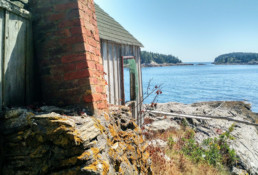
John Marin’s cabin on Carrying Place Head in Phippsburg, photographed by Portland Press Herald arts writer Bob Keyes. Keyes notes: “The island in the distance on the right is Wood Island. The photo also shows a bit of Little Wood Island on the left. There’s a small channel between them, which you can sort of see. As kids, we fished for flounder in that channel.”
Among Marin’s first Maine paintings was a view of Big Wood Island, which he could see from his “little shack.” It’s a quintessential action watercolor, the ledges and trees sketched in, lots of white paper lending light. The sea and sky are light blue washes, the island a small hump of pale green with a spine of black trees. It’s the kind of painting that led critic Alexander Brook to remark on the “extreme velocity” of Marin’s vision.
“Each picture,” he observed, “gives the spectator an eyeful in the swiftest sense of the word, what one might with the good fortune see in the twinkling of an eye.”
Marin came back to Phippsburg in 1915, continuing his exploration of the area. In a new Maine bicentennial-inspired book, At First Light: Two Centuries of Maine Artists, Their Homes and Studios, Bowdoin College Museum co-director Frank Goodyear relates how the painter used an advance from his New York dealer, the visionary photographer Alfred Stieglitz, to purchase a small island near West Point. In an act of proprietorship, he named it Marin Island. Although the diminutive retreat would prove inhospitable to Marin and his family, he painted it on a number of occasions.
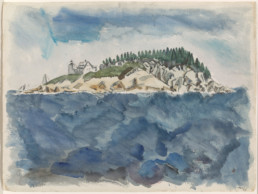
John Marin
Deer Isle Series: Mark Island Lighthouse
watercolor, 1928
16½ by 21¾ inches
Indeed, even after Marin moved north and east, first to Stonington and then to Cape Split in South Addison, he would return to his original Maine home, producing numerous watercolors of the area. He painted views of Morse Mountain, Popham Beach, and Ragged Island, which would become poet Edna St. Vincent Millay’s summer retreat in the 1930s and 1940s.
In a letter to Haskell’s son in March 1943 Marin described going “quite often” to Ragged “either in your Father’s Swampscott or outboard power boat.” He recalled how they both loved the island’s “bold wildness—then we’d get busy—he with his [etching] needle—I with my brush—and we’d never disturb one another and we’d get home—well—when we got home.”
In 1919, Marin and his family—his wife Marie and son John Jr.—spent their first summer in Stonington. If West Point had whetted his passion for islands, this new setting sent him over the moon.
“Some of the views with innumerable islands are bully,” he wrote Stieglitz on June 17 not long after arriving. By July 1 he had come to appreciate more fully the local bounty. “It seems that Old Man God when he made this part of the Earth just took a shovel full of islands and let them drop.”
Back in Stonington the following summer and fall (he stayed till early November), Marin reports watching the steamboats Bandwell and Morse coming and going. In August 1921, he recounts a boat ride to Isle au Haut and a fishing trip with Eddie Gross. “We got about 150 pounds of cod,” he tells Stieglitz. “I kept two. Eddie Gross can sell the rest, though it wouldn’t go bad to stop painting and sell fish.”
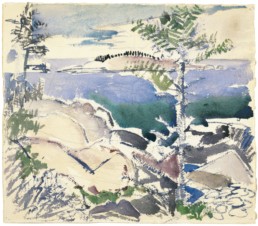
John Marin
Big Wood Island
opaque and transparent watercolor over graphite on wove paper, 1914
14¼ by 163/8 inches
In a Sept. 11, 1921, letter, Marin admits, “This Stonington is a cussed place, but if someone were to tell me I couldn’t come back here next year I’d be mad clear through.”
As was his MO, Marin took every chance to visit islands. On Aug. 13, 1922, he recounted a trip to a new island:
There is an island off here [Stonington] called Bold Island. I had never set foot on it before. Yesterday I did, and it’s rightly named. It’s Bold and that’s its name. It rises up in every direction and at the summit there are huge ledges of white granite and you sit down and look out over the sea and island and there is Scragg Island and Devil’s Island and Camp Island and many, many others and each has its special fascination. And then there is that wonderful high [Crotch Island] quarry with its sharp cutting forms. Yes, thank the Lord, at last I have an engine that has power and works.
Over the years Marin made a number of paintings of the Mark Island Light at the western entrance to the Deer Isle Thorofare. In the Portland Museum of Art’s watercolor from 1928, the square brick light tower and the lightkeeper’s house (which burned down in 1958) are sketched in along with the top of the boat house and a schooner sailing past.
Marin felt increasingly at home in his seasonal quarters.
“They are beginning to take me up into their bosoms here down East—they no longer class me in with the rusticators they being those who rusticate during the warm summer months—the white flannel nikers [knickers] brigade,” he proudly told Stieglitz in a Sept. 24, 1924, missive. “This place has gotten me by the nape of the neck,” he writes two years later, on Sept. 11, 1926. “Once I get here I forget other places, which is a failing I have that I am perfectly aware of.”
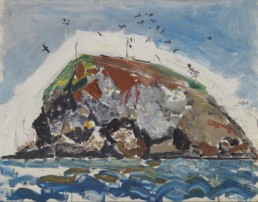
John Marin
The Ladle
oil on canvas, 1934
22 by 28 inches
For the most part Marin painted en plein air. In their expressionist verve, his paintings matched the dynamics of the landscape before him: the movements of sea, the twisted beauty of wind-blown trees, and the gnarly islands. He described the process in a letter from Small Point dated July 20, 1931:
Out door painting as such is just a Job—to get down what’s ahead of you—water you paint the way water moves—Rocks and soil you paint the way they were worked for their formation—Trees you paint the way trees grow. If you are more or less successful these paintings will look pretty well indoors for they have a certain rugged strength which will carry them off in a room—though they seemingly bear no relationship to the room.
In 1933, Marin took his family further Downeast, renting a house at Cape Split in South Addison. Once more, he found himself surrounded by islands.
“This place—little cottage—has a swell outlook over the waters—with the islands scattered about,” he reported to Stieglitz (Sept. 3, 1933). In another letter, to artist friend Emil Zoler (Sept. 14, 1933), Marin noted the profusion: “There are islands here—then some more islands—then a few thrown in for good measure.”
Marin would eventually paint many of them, including Jordan’s Delight, Outer Sand Island, Norton’s Island, Flint Island, and Sheep Island. He also went on painting excursions to Quoddy Head, Machias, Schoodic, and Mount Desert Island, and painted Tunk Mountain and Katahdin. As in Stonington, he made close friends with his neighbors, one of whom, Susie Thompson, would become a formidable artist-disciple.
At Cape Split, Marin began painting in oil more. As he wrote to Stieglitz on July 30, 1933, “I know that when I quit this Expression in Water Colors—the which I am now playing with—and get to the dignified—the high muck a muck medium Oils—I know that my clothes ‘l’ a’gin to have paint spots on em and that my wife ‘l’ a’gin to say things.”
Marin’s oils are as dynamic as his watercolors. Witness his rendering of The Ladle, a rocky eminence with high cliffs near the entrance to Cape Split harbor, which, looked at from one angle, resembles a long-handled spoon with a deep bowl set flat against the sea. Marin transforms the homely landmark into a kind of crazy quilt, the paint applied with gusto. The sky is alive with a swarm of seabirds while the ocean seems to leap across the bottom of the painting.
When Marin couldn’t get to Maine the summer of 1943, he sent a special request to his friend, the writer Herbert Seligmann: “Send down two bottles each hermetically sealed—one containing a Sample of that real old North Atlantic and too a sample of that genuine Cape Split salty ozone I think it will extend my period on this Shaky Crust we call the Earth.”
Sometime in the 1940s Marin began signing his letters with variations of “Yer ancient Mariner.” In the last letter in The Selected Writings of John Marin (1949) dated Aug. 26, 1948, and addressed to the book’s editor, photographer Dorothy Norman, the painter speaks of the islands, which remain “tantalizingly beautiful” and “work on” him. “They good company—I—I hope not too bad a—Subject.”
Marin suffered a stroke soon after arriving at Cape Split in 1953. Seven weeks later, on Oct. 2, he died just shy of his 82nd birthday. He is buried in Cliffside Park, near his home in New Jersey.
While Sheldon Reich stated at the end of the catalogue raisonné that “Marin was the beginning of no school of painting,” he inspired generations of painters to emulate his dynamic approach to painting. Whether in Terry Hilt’s dazzling watercolors of Monhegan or an Eric Hopkins North Haven sunset, the master’s modernist aesthetic lives on. And so do the islands Marin painted, those “tantalizingly beautiful” sentinels in the sea that kept good company and inspired some of his most memorable paintings.
Philip Booth ends his homage to the artist by highlighting the power of his:
riptide
paint, that, flooding,
tugs at your vitals
and is more Maine
than Maine.

